The mystery of how dinosaurs had sex
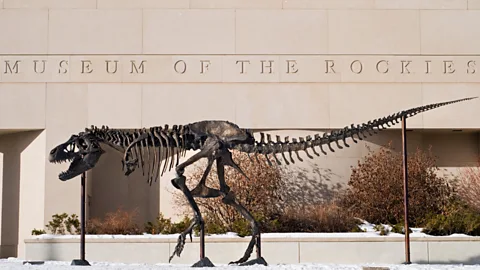 Alamy
AlamyThe sordid details of how dinosaurs got it on have long eluded scientists. Now there's a new idea emerging – could their most eccentric features tell us how they did it?
I'm sitting in Jakob Vinther's office, trying to get my head around whether tyrannosaurs had – there's no easy way to write this – penises. "So somebody has to be…" I stutter, becoming increasingly flustered. "…penetrated", finishes my host matter-of-factly.
We're at the University of Bristol, in the UK, where Vinther is a professor of macroevolution, specialising in the fossil record. I survey the room, mostly to avoid eye while I recover. It's exactly what your inner child would hope for from a palaeontologist.
The bookshelves are laden with a kind of fossil lasagne, where layers of academic tomes and paperwork are muddled up with relics from a lost world. Among the highlights are an ancient insect, with its delicate wing veins and mottled colouration clearly visible, the remains of a vampire squid with its black ink sacs so well-preserved they still contain melanin, and strange ancient worms related to those found today on coral reefs. In the corner is an antique wooden chest with drawers that – I hope – contain all kinds of other exciting petrified remains. The place feels like a cross between a museum and a library.
Mere feet away is the star of the show – a psittacosaurus, literally "parrot-lizard". This sweet little beaked herbivore and close relative of the triceratops is thought to have padded through the forests of what is now Asia around 133-120 million years ago. The specimen I'm looking at is world-famous – not for its skin, which is so intact you can still make out the streaky pattern on its body, or for its tail, which includes a distinctive spiky fringe of feathers. No, this dinosaur is best-known as the one that left its bottom behind for future generations to study (More on that later.)
I shift my attention back to our conversation. Vinther is telling me about a particularly titillating find from a renowned fossil site in China, the Yixian Formation in Liaoning province – where a pair of tyrannosaurs, complete with feathers, have been found next to one another in an ancient lake. Suspiciously close, if you ask him. In fact, what he wants to know is: were they having sex?
A (t)horny problem
With modern scientific techniques, scientists are uncovering breathtaking insights into the minutiae of dinosaur lives at a record pace – many of which would have been unthinkable decades ago.
Molecular detective work has identified red blood cells and collagen from 76-million-year-old therapods, the group that includes the largest predators to have stalked the Earth. It has revealed tell-tale chemical signatures that indicate triceratops and stegosaurs were, unusually for dinosaurs, cold-blooded – and that one spiky, heavily armoured herbivore, nodosaur, was ginger. Scientists have discovered that Spinosaurus – famous for the large 'sail' on its back – probably used its six-inch (15 cm) teeth and crocodile jaws to hunt in deep water, as well as evidence that iguanodons might have been surprisingly intelligent, and that pterosaurs (not technically dinosaurs, of course – they're actually winged reptiles) often walked to find their prey.
But research into exactly how dinosaurs mated – or in fact, anything at all about how they hooked up – has drawn a total blank. To this day, scientists can't even accurately distinguish males from females, let alone tell you how they courted or what kind of genitals they had. Without this fundamental knowledge, much of their biology and behaviour remains a total mystery. Only one thing is certain: they would have been doing it.
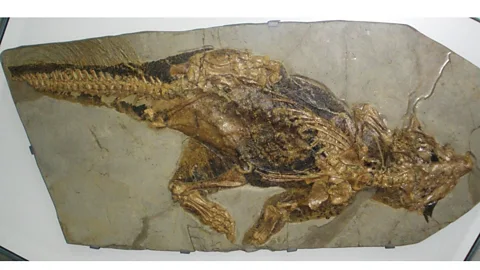 Wikimedia Commons/ Ghedoghedo
Wikimedia Commons/ GhedoghedoBack on the tyrannosaur fossils, Vinther explains that one clue to their compromising position might come from the site of another former lake, the Messel Pit in . This quarry-turned-fossil haven is legendary for its immaculately preserved flora and fauna, which often looks like it's been squashed between the pages of a book. So far it's yielded fox-sized horses, giant ants, early primates, and several animals with their full stomach contents – one involves a beetle inside a lizard, inside a snake. A large number of freshwater turtles have also been found – including at least nine couples that perished mid-way through an amorous encounter. In some cases, their tails are still touching, as they are during copulation. And this is crucial to his theory.
The Messel Pit is thought to be such a rich prehistoric graveyard because of a toxic secret. Back in the Eocene – between 57 million and 36 million years ago – it would have consisted of a water-filled volcanic crater with steep sides, surrounded by lush subtropical forest. No one knows exactly how it killed its victims, but one idea is that it remained geologically active after it formed, and periodically released clouds of suffocating carbon dioxide into the surrounding environment. It's possible that the unfortunate turtles were caught up in such an event, sinking to the bottom where their lust was preserved for millennia in a layer of anoxic silt.
However, the horny turtles aren't in the exact same sex positions that they were when they died – rather than one atop the other, as is usual, they're facing away from each other, as though they've both suddenly changed their minds.
Sensing my bafflement, Vinther leans back in his chair and, with the air of someone for whom prehistoric sex is a perfectly normal conversation topic, explains that after the turtles died, they would have drifted apart but remained attached by their genitals. They've been locked together all this time by the male partner's, ahem, reproductive anatomy.
And this leads us back to the pair of fossilised tyrannosaurs, where there are some uncanny parallels. "They're pointing away from each other, and their tails overlap each other," says Vinther. "I believe that they were caught in the act."
Without other examples, Vinther acknowledges that the theory is highly speculative, and as yet it's just an unpublished idea. However, if the animals really are locked in an ancient embrace, it would tell us something about a certain soft organ that no one has yet found fossilised. That's right, it's just possible that tyrannosaurs – including, presumably, T. rexes – had penises.
A bottom on a lake bottom
However, there is another, less ambiguous source of dinosaur sex facts – a fossil that has captivated the world's attention with its behind. This is the psittacosaurus.
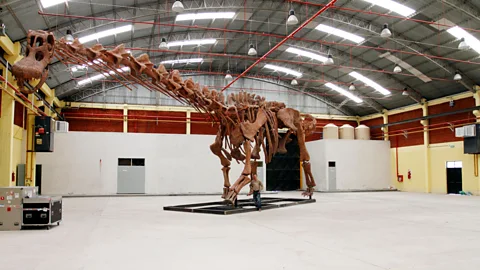 Alamy
AlamyVinther walks me over to his prized possession, and talks me though its backstory.
It's the Early Cretaceous in the Jehol Biota – an ancient ecosystem in northeastern China. Let's say it's a beautiful sunny day in this temperate land, and the little psittacosaurus decides to leave her densely forested home to go for a drink in one of the area's many lakes. She's around three feet (91cm) long from head to tail – reminiscent of an unusually stocky Labrador – and nearly a full adult, but she's still inexperienced.
The psittacosaurus potters over to the water's edge on two feet – she stopped walking on all fours as she got older – but then tragedy strikes. Just as she's leaning down for a sip with her parrot-like beak, she slips, falls in and drowns. As she plunges to the bottom of the lake, she ends up inelegantly splayed on her back – accidentally preserving her genitals for future apes to wonder over.
Naturally, Vinther is particularly keen for me to check out this famous bottom. He points out a dark, round patch of skin just below her tail – and there it is: a dinosaur's private parts, preserved against all odds since the Early Cretaceous, a time so distant that it's equivalent to around 1.6 million average human lifespans.
Alas, the psittacosaurs in Vinther's office is not the actual fossil – what I'm looking at is a scale model of the animal as it would have been in life, that he commissioned himself. But what a model it is – painstakingly crafted to be as accurate as possible, even the markings are accurate, based on the exact streaks found on the fossilised skin of the original.
So, what does this little dinosaur's rear quarters tell us?
First up, like the closest relatives of dinosaurs – birds and crocodiles – this individual has a cloaca. These multipurpose openings are common in all land-living vertebrates except mammals, and involve a single orifice through which they defecate, urinate, have sex and give birth. This was not unexpected, but is a new discovery – no one had ever confirmed that dinosaurs had the same anatomy as their evolutionary cousins.
"So you can see, if you look underneath here [he gestures towards the psittacosaurus' cloaca, under its tail] – there's lots of pigment," says Vinther. He explains that this is melanin, and it might be partly responsible for the extraordinary level of preservation in this specimen.
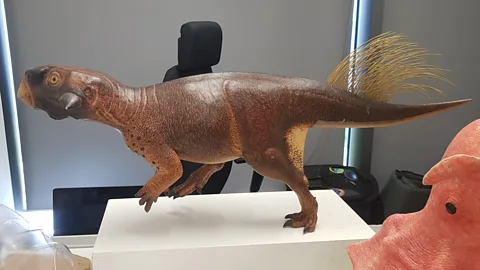 Zaria Gorvett
Zaria GorvettThough we tend to think of melanin as the dark compound that gives our skin its colour, it has a kaleidoscopic range of uses in the natural world, from its application as a pigment in squid ink to its function as a protective layer at the backs of our eyes. It's also a potent antimicrobial – in amphibians and reptiles, it's commonly found in high concentrations in the liver, where it prevents the growth of potentially harmful microbes. But crucially, it's also found in many other situations where this would be useful.
"For example, the insects… they use melanin as a sort of immune system to protect against infection. So if you poke a hole in a moth, for example, with a needle [this is not recommended], then the area around where you poke the hole will secrete melanin," says Vinther.
For this reason, many animals, including humans, have higher concentrations of melanin – and therefore, darker skin – around the genitals. And this is just as true for dinosaurs as it is for humans. Looking at the distant relative in front of me, who – as one of my colleagues pointed out – is frozen in a pose as though they're trying to tiptoe past me, it feels odd to recognise such an intimate similarity.
But there are other intriguing finds, and here it becomes clear that all my discomfort so far has merely been a warm-up. Before I know what's happening, Vinther is enthusiastically explaining the many other features of the psittacosaurus' bottom in an arresting level of detail.
"Now we can reconstruct the morphology of the cloaca, and we can show that it had like sort of two sort of lips that sort of flared out like this," says Vinther, making a V-shape with his fingers. "And on the outside, there were pigmented. But here's the interesting thing, because it's not around the opening, [as it would logically be] if it was for microbial infection. So they were they putting pigment there to ."
If this is true, it would be unprecedented – advertising your bottom to potential mates, as baboons do, is extremely unusual in modern birds, the descendants of the avian dinosaurs. "They use a lot of visual signalling," says Vinther, explaining that they have excellent colour vision – unlike most mammals which can only see two colours, birds can see the three humans can as well as ultraviolet light. "But it's pointless to show your cloaca because it's covered in feathers." Equally, crocodiles rely more on scent.
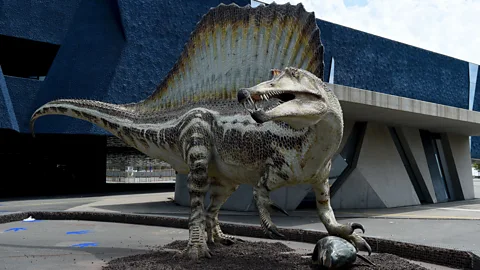 Getty Images
Getty ImagesVinther speculates that like birds, dinosaurs may also have had excellent colour vision, in which case it makes sense that those that lacked feathers may have taken the opportunity – "why not your cloaca">window._taboola = window._taboola || []; _taboola.push({ mode: 'alternating-thumbnails-a', container: 'taboola-below-article', placement: 'Below Article', target_type: 'mix' });
